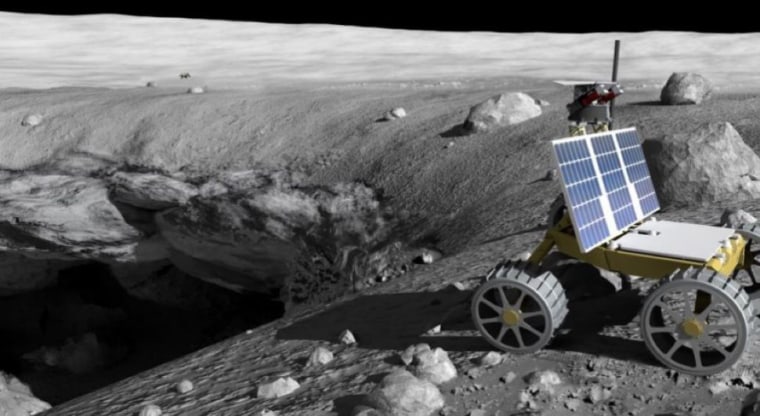With funding from NASA, researchers are working to build robots that can explore moon pits, sinkhole-like structures that could be full of resources and could even make good astronaut homes.
The grant comes as part of NASA's Artemis mission, which is slated to return humankind to the lunar surface by 2024. The $2 million research initiative awarded to roboticists at Carnegie Mellon University (CMU) will help develop robots specialized to enter moon pits. Researchers at CMU consider those pits a key priority for the resource use and habitat construction they see as part of future lunar development.

The pits in question resemble sinkholes here on Earth. While craters on the moon are created from impacts with objects like asteroids, these pits form when the moon's surface collapses. Some scientists suspect that these pits could reveal larger caverns under the moon's surface that could protect humans from radiation.
Related: Here's Where Commercial Landers Will Land on the Moon for NASA
But scientists can't know for sure without looking inside, and that would be dangerous for humans to do. So in order to find out for sure how well these pits would work for future lunar inhabitants and what the features might contain, NASA wants robots that can explore the depressions.
That's where the new contract comes in: The robots being developed could collect data about the pits and help to develop models of the features, which have previously been studied only with orbital images.
"From orbit, you can't get the viewpoints or proximity to see the details that matter," William Whittaker, a roboticist at Carnegie Mellon University who is heading up the project, said in a press release. "That's why we need robots. Is there a way in? Are there overhangs? Could a robot rappel in? Might there be a fissure, cavern or cave opening?"
Creating robots capable of such a mission will be a feat. These robots will have to be fast and agile, traversing many miles over a variety of types of terrain. They will also have to be able to know their way "home," to a companion lander that will be better able to communicate with Earth.
The rovers will also need what Whittaker calls "exploration autonomy," or the ability to make their own judgements about where exactly to go and how close to get to the edge of those moon pits.
The funding for this project will come from the NASA Innovative Advanced Concepts (NIAC) program. NIAC supports "high-risk/high-payoff" projects. The Carnegie Mellon project will also incorporate teams at the NASA Ames Research Center in California and Astrobotic. That company develops space robotic technology and is building one of the first commercial landers NASA has hired to ferry experiments to the moon.
- Mars Explored: Landers and Rovers Since 1971 (Infographic)
- How NASA's Mars Rovers Spirit and Opportunity Work (Infographic)
- How NASA's Mars 2020 Rover Will Work (Infographic)
Follow Chelsea Gohd on Twitter @chelsea_gohd. Follow us on Twitter @Spacedotcom and on Facebook.
SIGN UP FOR THE MACH NEWSLETTER AND FOLLOW NBC NEWS MACH ON TWITTER, FACEBOOK, AND INSTAGRAM.

